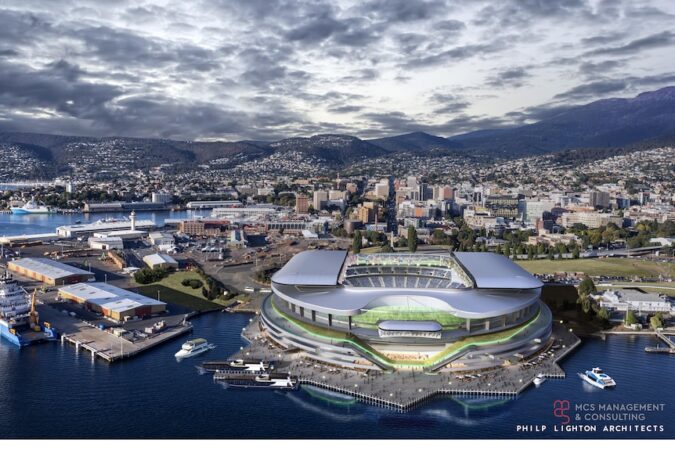
The Tasmanian government has sunk an alternative proposal for a stadium on Hobart’s waterfront, claiming it would not meet its contractual requirements with the AFL.
Paul Lennon, who was Labor premier between March 2004 and May 2008, has released alternative plans that would see a stadium built on further reclaimed land in the River Derwent, using private sector financing.
It comes in the same week the government plans to bring on a vote in parliament to have its preferred location 200 metres away at Macquarie Point assessed by the state’s planning commission.
The plans from Mr Lennon and Tasmanian engineer Dean Coleman show the stadium would extend 250 metres into the Derwent, built on an additional 800,000 cubic metres of reclaimed land.
It would sit alongside the regatta grounds — a similar location to the initial proposal from former premier Peter Gutwein.
This was changed to Macquarie Point following a visit to Hobart by AFL executives.
Mr Lennon and Mr Coleman’s plans include 450 apartments attached to the stadium, 5,000 underground parking spaces, a private hospital, hotel and convention centre.
Mr Coleman estimated the stadium would cost $750 million, with the total development to cost $2.3 billion.
He said a public-private partnership model would be used.
“Those commercial developments actually inject the funds to pay for the peripherals of the stadium,” Mr Coleman said.
“That’s why our stadium is a $750 million project. The 2.3 (billion dollars) is all the other commercial development around the precinct, but all of those commercial developments actually inject funds into the project.”
Mr Coleman said they were seeking international finance for the project.
“The stadium itself will be a public-private partnership. Tasmanian people will own the stadium from day one, and the rest of the development is just traditional investors investing in accommodation, commercial, hospitals and the like,” he said.
Former Adelaide Crows chairman Rob Chapman is the project’s financial advisor.
Some applaud alternative idea as good use of space
The Commonwealth has promised $240 million for the state government’s proposal, contingent on it including housing for frontline health workers and veterans, along with social housing, wharf upgrades and consultation with the Aboriginal community.
The Aboriginal Heritage Council has already voiced its disapproval over the removal of an Aboriginal cultural centre from the plans, despite the inclusion of a “culturally informed” park.
Hobart City Council has also been critical of the government’s plan, believing it is an unsuitable and rushed use of available public land.
The council has been briefed by Mr Coleman and Hobart Lord Mayor Anna Reynolds said the alternative design appeared to be more appropriate.
“It is a very serious proposal, it’s a serious consortium,” she said.
“I think it’s really good to have more than just the Macquarie Point proposal on the table.
“They’ve also really thought about some of the problems with building a stadium in that fairly limited space at Macquarie Point.
“My understanding is it leaves Macquarie Point with a bit more room to move to do the housing, or the Antarctic and science precinct, or back to the reconciliation art park.”
Independent MP Lara Alexander — who quit the Liberals in May over concerns about the stadium proposal — said she preferred the alternative idea.
“It is very good to see the business sector coming together and actually offering a solution to the government,” she said.
“The fear has been all along that this is a huge project with the risk that was basically carried fully and completely by the state government.”
The government requires her vote in the lower house to pass legislation.
Government committed to Macquarie Point
Stadia and Events Minister Nic Street said the contract for a Tasmanian AFL team required a stadium at Macquarie Point.
“While we have been provided information on an alternative concept at Regatta Point that includes a stadium, there is no detailed business case or funding secured for what is an incredibly ambitious project,” he said.
“The alternative site proposed is owned by the Hobart City Council, not the Tasmanian government, and the scale of the proposal means it is far more complex and with that comes a higher level of risk.
“While we have always indicated we are open to private investor interest in a stadium, it is important that we are able to deliver on what has been committed to and by 2028.”
The government released a draft precinct plan for Macquarie Point on the weekend, showing the stadium would be the first stage, followed by housing and an Aboriginal cultural park, and commercial development.
A final plan would be provided to the Commonwealth — along with wharf upgrade plans — to receive $240 million in funding.
LoadingLoading…
Source: AFL NEWS ABC



